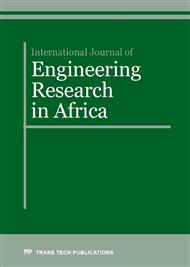p.1
p.7
p.13
p.24
p.33
p.52
p.64
p.72
p.80
Potentiodynamic Polarization of Brass, Stainless and Coated Mild Steel in 1M Sodium Chloride Solution
Abstract:
Enormous funds are spent on the protection of engineering components and structures annually as a result of corrosion. Degradation sets in, due to electrochemical reaction that takes place between materials and the environment leading to reduced performance. The associated downtime caused by replacement and maintenance of vessels, pipes, valves and other equipment necessitated seeking for techniques and method to efficiently combat corrosion. This study evaluated the potentiodynamic polarization of brass, Coated Mild Steel (CMS) and Stainless Steel (SS) in sodium chloride (NaCl). The samples (1 x 30 x 30 mm3) were used as working electrodes for Potentiodynamic Polarization Experiment (PPE). The samples were cleaned, and soaked in 1M NaCl solution. Open circuit potentials and current densities of the samples were obtained from PPE which were used to evaluate their corrosion rates. The pH of the media was recorded before and after each experiment. The results obtained using PPE in NaCl (in mm/y) were 0.209, 0.0053 and 0.0046; for brass, MSC and SS respectively. The pH of the medium was measured as 10.9.The results revealed that brass had highest corrosion rate in the medium. The least corrosion rate was obtained for Stainless Steel in 1M NaCl followed by Coated Mild Steel.
Info:
Periodical:
Pages:
1-6
Citation:
Online since:
April 2016
Price:
Сopyright:
© 2016 Trans Tech Publications Ltd. All Rights Reserved
Share:
Citation:


